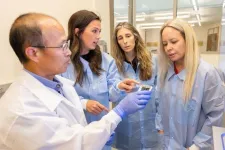(Press-News.org) A new study from the University of Toronto's Department of Civil & Mineral Engineering suggests that large-scale adoption of electric vehicles (EVs) could lead to significant population-level health benefits.
The research team used computer simulations to show that aggressive electrification of the U.S. vehicle fleet, coupled with an ambitious rollout of renewable electricity generation, could result in health benefits worth between US$84 billion and 188 billion by 2050.
Even scenarios with less aggressive grid decarbonization mostly predicted health benefits running into the tens of billions of dollars.
“When researchers examine the impacts of EVs, they typically focus on climate change in the form of mitigating CO2 emissions,” says Professor Marianne Hatzopoulou, one of the co-authors of the study, which is published in PNAS.
“But CO2 is not the only thing that comes out of the tailpipe of an internal combustion vehicle. They produce many air pollutants that have a significant, quantifiable impact on public health. Furthermore, evidence shows that those impacts are disproportionately felt by populations that are low-income, racialized or marginalized.”
Other members of the team include lead author and postdoctoral fellow Jean Schmitt, Professors Daniel Posen and Heather Maclean, and Amir F.N. Abdul-Manan of Saudi Aramco’s Strategic Transport Analysis Team.
Members of this team had previously used their expertise in life-cycle assessment to build computer models that simulated the impact of large-scale EV adoption in the U.S. market.
Among other things, they showed that while EV adoption will have a positive impact on climate change, it is not sufficient on its own to meet the Paris Agreement targets. They recommended that EV adoption be used in combination with other strategies, such as investments in public transit, active transportation and higher housing density.
In their latest study, the team wanted to account for the non-climate benefits of EV adoption. They adapted their models to simulate the production of air pollutants that are common in fossil fuel combustion, such as nitrogen oxides, sulphur oxides and small particles known as PM2.5.
“Modelling these pollutants is very different from modelling CO2, which lasts for decades and ends up well-mixed throughout the atmosphere,” says Posen.
“In contrast, these pollutants, and their associated health impacts, are more localized. It matters not only how much we are emitting, but also where we emit them.”
While EVs do not produce any tailpipe emissions, they can still be responsible for air pollution if the power plants that supply them run on fossil fuels such as natural gas or coal. This also has the effect of displacing air pollution from busy highways to the communities that live near those power plants.
Another complication is that neither the air pollution from the power grid nor that from internal combustion vehicles is expected to stay constant over time.
“Today’s gasoline-powered cars produce a lot less pollution than those that were built 20 years ago, many of which are still on the road,” says Schmitt.
“So, if we want to fairly compare EVs to internal combustion vehicles, we have to account for the fact that air pollution will still go down as these older vehicles get replaced. We can also see that the power grid is getting greener over time, as more renewable generation gets installed.”
In the model, the team chose two main scenarios to simulate out to the year 2050. In the first, they assumed that no more EVs will be built, but that older internal combustion vehicles will continue to be replaced with newer more efficient ones.
In the second, they assumed that by 2035, all new vehicles sold will be electric. The researchers described this as “aggressive,” but it is in line with the stated intentions of many countries. For example, Norway plans to eliminate sales of non-electric vehicles next year, and Canada plans to follow suit by 2035.
For each of these scenarios, they also considered various rates for the transition of the electric grid to low-emitting and renewable energy sources, i.e., whether it stays roughly the same as the current rate, slows down, or accelerates over the next couple of decades.
Under each of these sets of conditions, the team simulated levels of air pollution across the United States. They then used established calculations commonly used by epidemiologists, actuaries and government policy analysts to correlate these pollution levels with statistical estimates of the number of years of life lost, as well as with estimates of economic value.
“Our simulation shows that the cumulative public health benefits of large-scale EV adoption between now and 2050 could run into the hundreds of billions of dollars,” says Posen.
“That’s significant, but another thing we found is that we only get these benefits if the grid continues to get greener. We are already transitioning away from fossil fuel power generation, and it’s likely to continue in the future. But for the sake of argument, we modelled what would happen if we artificially freeze the grid in its current state. In that case, we’d actually be better off simply replacing our old internal combustion vehicles with new ones — but again, this is not a very realistic scenario.”
This finding raises another question: is it more important to decarbonize the transportation sector through EV adoption, or to first decarbonize the power generation sector, which is the ultimate source of pollution associated with EVs?
“To that I would say that it’s important to remember that the vehicles being sold today will continue to be used for decades,” says Hatzopoulou.
“If we buy more internal combustion vehicles now, however efficient they may be, we will be locking ourselves into those tailpipe emissions for years to come, and they will spread that pollution everywhere there are roads.
“We still need to decarbonize the power generation system — and we are — but we should not wait until that process is complete to get more EVs on the road. We need to start on the path to a healthier future today.”
END
New research reveals how large-scale adoption of electric vehicles can improve air quality and human health
Large-scale adoption of EVs in the U.S. market, coupled with ambitious grid decarbonization, could result in more than US $100 billion in health benefits by 2050
2024-10-15
ELSE PRESS RELEASES FROM THIS DATE:
Florida Inventors Hall of Fame invites nominations for 2025 inductees
2024-10-15
TAMPA, Fla. (Oct. 15, 2024) -- The Florida Inventors Hall of Fame is inviting nominations for the 2025 class of inductees. This award recognizes distinguished inventors with a connection to Florida, whose achievements have advanced quality of life for the state and the nation.
“Inductees to the Florida Inventors Hall of Fame represent some of our nation’s greatest inventors from across academia, industry and government,” said Paul Sanberg, chair of the Florida Inventors Hall of Fame Advisory Board and president of the National Academy of Inventors. “Their achievements underscore the critical role that innovation plays in driving ...
Election officials can boost voter trust in delayed results with early communication
2024-10-15
In recent U.S. elections, results often took days to finalize, fueling voter distrust in the electoral process and ballot outcomes. Now, research from the Yankelovich Center for Social Science Research at UC San Diego shows that a simple, proactive message from election officials – ahead of Election Night – can effectively reduce this distrust.
The study, published in PNAS Nexus, reveals that when voters are informed in advance that counting ballots accurately takes time and there are security measures in place, their trust in the process remains steady, even when results are delayed.
“Election officials ...
Rice-led research will leverage responsible AI to enhance coastal communities’ severe storm response
2024-10-15
HOUSTON – (Oct. 15, 2024) – An interdisciplinary team of Rice University engineers and collaborators led by Jamie Padgett has won $1.5 million from the National Science Foundation (NSF) to improve the safety and resiliency of coastal communities facing compounded risk from hazardous weather events.
Padgett, together with Ben Hu and Avantika Gori at Rice, David Retchless at Texas A&M University at Galveston and community partners, will leverage responsible artificial intelligence (AI), hazard and resilience models ...
Honey bees in demand: New contract strategies to support pollination services
2024-10-15
URBANA, Ill. — As the world’s native bee populations are declining, crop production requiring pollinators increasingly relies on commercial pollination services. In the U.S., the beekeeping industry is in great demand, and truckloads of bee colonies travel the country to accommodate crop growers. A new study from the University of Illinois Urbana-Champaign looks at pollination contracts between beekeepers and California almond growers, exploring clauses that could make the agreements more appealing for both parties.
“There's about 1.3 million acres of almond trees ...
New climate change health research center under development at the University of Cincinnati
2024-10-15
Climate change presents far-reaching implications for the planet’s weather, sea levels, animals and food supply. Now experts are addressing climate change’s adverse effects on human health.
“We need to try to reduce risks for people, especially vulnerable populations,” said Ardythe Morrow, PhD, MSc, professor and director of the Epidemiology division of the Department of Environmental and Public Health Sciences at the University of Cincinnati College of Medicine.
To that end, the National Institute of Environmental Health Sciences of the National Institutes of Health has awarded a three-year, $4 million ...
Educational psychologists can play a part in fighting TikTok mental health and neurodiversity misinformation
2024-10-15
Educational psychologists could help to fight mental health and neurodiversity misinformation on TikTok as more young people self-diagnose based on poor quality content on the platform, a new study says.
Growing numbers of young people may be labelling themselves as being neurodivergent or having mental health conditions after engaging with information online, some of which may be inaccurate.
Educational psychologists and their professional bodies could engage with TikTok by creating accessible evidence-based content about neurodiversity and mental health on the platform.
Their assessments could also ...
Winners announced in $300,000 pediatric medical device competition focused on pediatric cardiology
2024-10-15
WASHINGTON (Oct. 15, 2024)—Six medical technology innovators focused on pediatric cardiology were selected to receive grants of $50,000 each in the “Make Your Medical Device Pitch for Kids!TM” competition in Toronto. The funds will help awardees bring their devices to the market and improve care for children with heart conditions.
The awardees, selected from a highly competitive field of ten finalists, are:
Bloom Standard, Minneapolis—Autonomous, hands-free ultrasound
Compremium AG, Bern, Switzerland—Noninvasive central venous pressure estimation for pediatric patients
Massachusetts ...
New app performs real-time, full-body motion capture with a smartphone
2024-10-15
Northwestern University engineers have developed a new system for full-body motion capture — and it doesn’t require specialized rooms, expensive equipment, bulky cameras or an array of sensors.
Instead, it requires a simple mobile device.
Called MobilePoser, the new system leverages sensors already embedded within consumer mobile devices, including smartphones, smart watches and wireless earbuds. Using a combination of sensor data, machine learning and physics, MobilePoser accurately ...
Immune signatures may predict adverse events from immunotherapy
2024-10-15
Distinct immune “signatures” in patients who develop adverse events while taking immunotherapy for cancer may help oncologists identify patients at risk and treat them early to prevent serious side effects, suggests a study by researchers from the Johns Hopkins Kimmel Cancer Center and its Bloomberg~Kimmel Institute for Cancer Immunotherapy.
The study, published Oct. 15 in the Journal of Clinical Investigation, is the largest to date to look at immune signatures in patients with a range of cancers. It included a diverse sample of 111 patients treated with immune checkpoint inhibitors ...
UTA invests in cutting-edge genomic research technology
2024-10-15
The North Texas Genome Center (NTGC) at UT Arlington is getting an upgrade in the form of a next-generation genetic sequencer that will allow researchers to study genetic links between health and disease at a large scale. The new $1 million instrument, the only one of its kind in North Texas, will allow faculty and students to more deeply analyze rare genetic variants, an important step in discovering new insights for the future of health care.
“I’m excited to be able to expand and upgrade the technological capabilities of the North Texas Genome Center, a collaborative ...
LAST 30 PRESS RELEASES:
Scientists use ultrasound to soften and treat cancer tumors without damaging healthy tissue
Community swimming program for Black youth boosts skills, sense of belonging, study finds
Specific depressive symptoms in midlife linked to increased dementia risk
An ‘illuminating’ design sheds light on cholesterol
Who is more likely to get long COVID?
Study showcases resilience and rapid growth of “living rocks”
Naval Research Lab diver earns Office of Naval Research 2025 Sailor of the Year
New Mayo-led study establishes practical definition for rapidly progressive dementia
Fossil fuel industry’s “climate false solutions” reinforce its power and aggravate environmental injustice
Researchers reveal bias in a widely used measure of algorithm performance
Alcohol causes cancer. A study from IOCB Prague confirms damage to DNA and shows how cells defend against it
Hidden viruses in wastewater treatment may shape public health risks, study finds
Unlock the power of nature: how biomass can transform climate mitigation
Biochar reshapes hidden soil microbes that capture carbon dioxide in farmland
Reducing saturated fat intake shows mortality benefit, but only in high-risk individuals
Manta rays create mobile ecosystems, study finds
Study: Mixed results in using lipoic acid to treat progressive multiple sclerosis
Norbert Holtkamp appointed director of Fermi National Accelerator Laboratory
New agentic AI platform accelerates advanced optics design
Biologists discover neurons use physical signals — not electricity — to stabilize communication
Researchers discover that a hormone can access the brain by hitchhiking
University of Oklahoma researcher awarded funding to pursue AI-powered material design
Exploring how the visual system recovers following injury
Support for parents with infants at pediatric check-ups leads to better reading and math skills in elementary school
Kids’ behavioral health is a growing share of family health costs
Day & night: Cancer disrupts the brain’s natural rhythm
COVID-19 vaccination significantly reduces risk to pregnant women and baby
The role of vaccination in maternal and perinatal outcomes associated with COVID-19 in pregnancy
Mayo Clinic smartwatch system helps parents shorten and defuse children's severe tantrums early
Behavioral health spending spikes to 40% of all children’s health expenditures, nearly doubling in a decade
[Press-News.org] New research reveals how large-scale adoption of electric vehicles can improve air quality and human healthLarge-scale adoption of EVs in the U.S. market, coupled with ambitious grid decarbonization, could result in more than US $100 billion in health benefits by 2050



